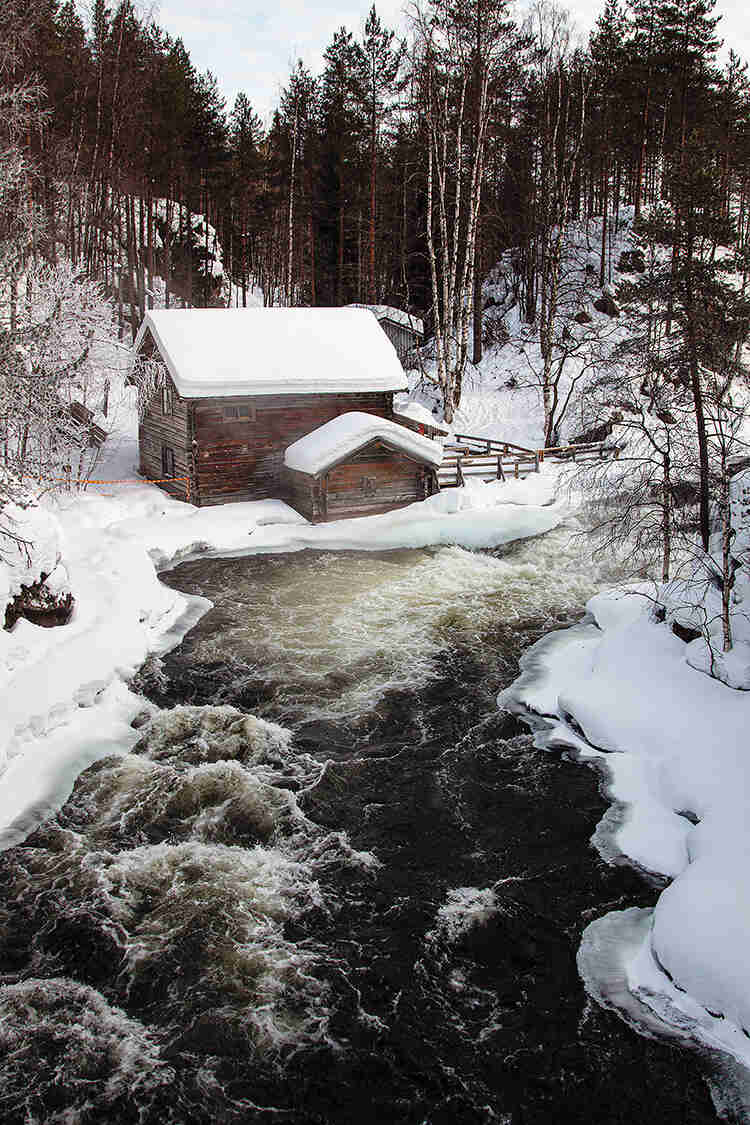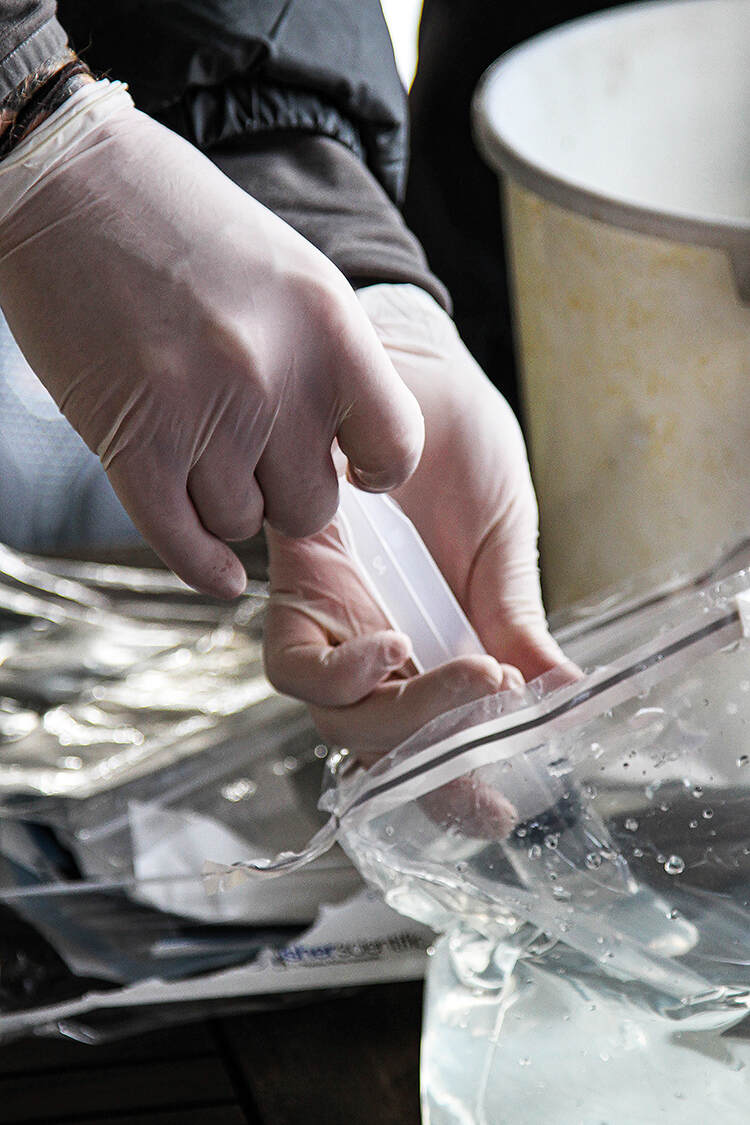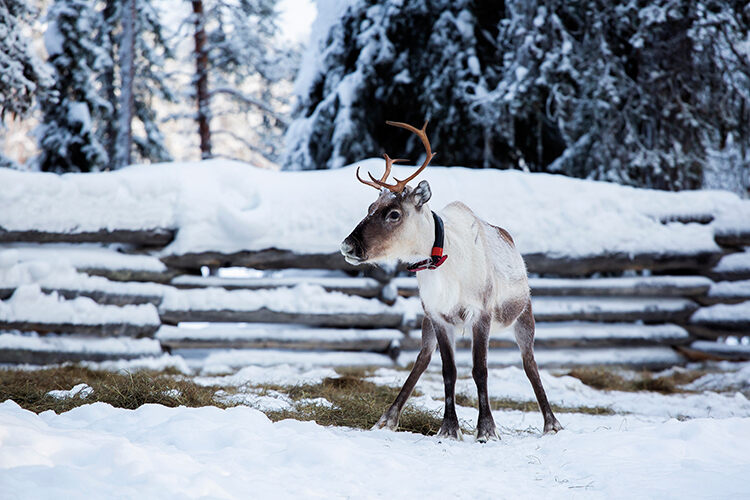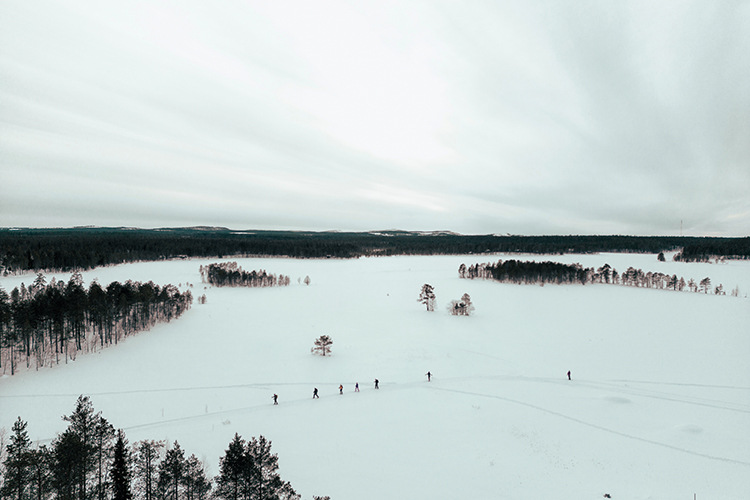
Bryony Cottam joins an expedition collecting environmental DNA in Finland as part of an ambitious plan to build a biodiversity atlas
Do you know what to do if you meet a bear in the woods?’ Martti Latva-Kurikka calls out over the roar of the river. ‘Don’t try to look big – because the bear might see it as a challenge – and don’t look it straight in the eyes. Instead, you should look humble and talk to it slowly. And since we’re in Finland, you have to talk in Finnish: “Kiltti pikku karhu älä syö minua.” Please little bear, don’t eat me.’
It’s March and a thick layer of snow blankets the boreal forests of Oulanka National Park. This last winter has been an unusually mild one for Finland, but still there’s enough snow to cause the forest’s slender birch trees to bend double under its weight. Beneath the snow, bears are sleeping. In a few weeks’ time, they’ll begin to wake up, but they won’t cause the summer tourists – who come to walk the park’s many trails – any trouble. ‘I have never seen a bear and I’m not expecting to see one,’ says Latva-Kurikka, who has almost finished his seventeenth season as a park guide.
Finnish bears are smart, he says, and stay well clear of humans. A few of the park’s population wear GPS collars that were fitted by researchers from the University of Oulu. When university students tried to track the bears, they found that every time they got close, the bears’ GPS signals moved further away. ‘They never saw them.’

One of the key challenges in wildlife conservation is knowing which species are living where. Tagging bears, or any other species, is often a stressful experience for the animal – which must be caught, restrained and, in some cases, sedated – and a labour-intensive job for the scientist. There are other, less-invasive monitoring methods such as surveys and camera traps, but these too have their disadvantages (time-consuming/costly and easily damaged or stolen respectively). Increasingly, scientists and conservationists are turning to new technologies to assess biodiversity, from artificial intelligence to acoustic sensors that are used to record animal sounds (an emerging scientific field known as ecoacoustics). One method in particular has already demonstrated its potential to revolutionise wildlife monitoring: eDNA.
All animals, including humans, are constantly shedding their DNA in the form of dead skin and hair cells, and secretions such as mucus and faeces. This organic matter accumulates in the animal’s surrounding environment – in the soil, water and even the air – where the DNA can last for several weeks. This environmental DNA – eDNA – can be collected in soil or water samples and, thanks to the advancement of DNA-sequencing technology, can be used to identify species that have recently been present in an area.
Scientists first started researching the possibility of using eDNA to assess biodiversity levels during the early 2000s. One of the technique’s pioneers was molecular ecologist Kat Bruce, co-founder of DNA-based-biodiversity-monitoring services NatureMetrics. ‘We’ve been banging the drum about this for a long time, so it’s very exciting to see it suddenly starting to scale and filter into the mainstream,’ she says. In April 2020, after hosting a well-attended webinar on eDNA, Bruce was approached by the International Union for Conservation of Nature (IUCN), which proposed a collaboration with their freshwater-species team. ‘And so we sort of challenged ourselves to find the biggest, most exciting idea that we could come up with for this technology, which was basically to map the world’s biodiversity.’ The resulting project – named the eBio Atlas – promises to capture biodiversity data at ‘previously unimaginable scales’, starting with the world’s freshwater habitats.

Freshwater ecosystems are disproportionately important for biodiversity – they cover just one per cent of the Earth’s surface but are home to 30 per cent of all known vertebrates. They’re also some of the world’s most threatened habitats. Due to a combination of pollution, climate change, waterside development and invasive species, freshwater habitats are currently experiencing biodiversity loss at a rate estimated to be two to three times that of terrestrial and marine habitats.
But Bruce says that without knowing which species are living in a location at any point in time, it’s impossible to tell whether our conservation efforts are making a difference, no matter how many targets we set. ‘The IUCN will tell you that they have the gold-standard datasets on biodiversity, but some of their records come from the late 1800s,’ she says. ‘They’re not up-to-date and they’re very patchy. There simply is no global, harmonised, high-quality, up-to-date biodiversity baseline.’

It has long been known that Oulanka National Park is an exceptional hotspot of biodiversity. ‘The Oulanka area has always fascinated natural scientists and the oldest written document of the area is from 1770,’ reads a snow-topped sign next to the well-trodden Bear Trail. Riku Paavola, senior research scientist and station manager at the Oulanka Research Centre (part of the University of Oulu), says that there are a number of reasons for this. ‘Possibly the most important one is that most of the bedrock in Finland is slightly acidic by nature, but in this area there’s also a large outcrop of calcium-rich bedrock, which is very abnormal in this country.’ What this means is that within just 30–50 kilometres, the acidity of a river can change from pH 5.5 to 8.7. ‘When you remember that pH is on a logarithmic scale, you realise that’s a staggering gradient, one that automatically creates different kinds of living conditions for different species.’ Another factor is the direction in which the park’s rivers flow: east, where they drain into Russia’s White Sea (most of Finland’s rivers flow south to the Baltic Sea). ‘The rivers have definitely acted as corridors of colonisation for a lot of plant species,’ says Paavola.
Standing on the riverbank and leaning out over the park’s turbulent Myllykoski rapids, Latva-Kurikka scoops up river water with a sample collector. It’s homemade – an empty cream cheese tub nailed to a length of wood. A few more scoops and the sample bag is full and ready to be filtered. It’s the third bag of the day; the first two were filled from the park’s Juuma lake. We’d had to cut through 50 centimetres of ice with a hand-powered ice auger to collect the samples, but the lake’s deep, dark waters contained the tiny traces of the animals that live in it, and it was our job to find them.

Earlier in the week, our group had arrived in the small town of Kuusamo, in northeastern Finland, where we first met our guide, Latva-Kurikka. From there, he’d driven us almost an hour north to Basecamp Oulanka, a wilderness resort at the southern tip of the national park where tourists can try ice fishing and cross-country skiing. The park lies just south of the Arctic Circle, and the snow-ploughed roads were walled in by dense spruce forest. Occasionally we passed houses painted in primary reds, blues and yellows – not that we could see them through the dark of the polar night.
We’d come to take part in a citizen science project, one of 18 launched this year by tour operator Exodus, in partnership with NatureMetrics. Each of these projects has been added as a bonus activity on a number of Exodus’s existing tours in destinations worldwide, from the Peruvian Amazon to Zambia’s Zambezi Valley to here in Oulanka National Park, and each will contribute data to the eBio Atlas. Exodus calls them ‘citizen science departures’.
Citizen science is set to play a big role in the development of the eBio Atlas. ‘There’s a lot of stuff that you cannot do in citizen science, because you need trained scientists,’ says Paavola, ‘but bringing samples from hard-to-reach places is one way in which we’ve seen that citizen science can be highly useful.’ So far, NatureMetrics has set a three-year goal of collecting 30,000 freshwater samples from areas of critical conservation importance, but Bruce hopes to attract a big, philanthropic funder that will help to roll the project out across the world. Collecting all of that data is going to require a lot of data-collectors.

Back at Basecamp Oulanka, where we’ve taken our samples for filtering, things start to go wrong when we spill half of one bag over the floor. We calculate how many syringes of water need to pass through each filter for it to have enough DNA material, then repeatedly lose count. Gloves get forgotten and filters are put on back to front. Surprisingly, none of this has a significant impact on our results; when the sample report comes back two months later, it notes that DNA from all four filters was successfully extracted and analysed, and that the data are of a ‘high quality’. ‘It’s amazingly robust,’ says Bruce. ‘I’ve gone head to head with my colleagues’ five-year-old daughter and you can’t tell the difference between the data that came from her sample and the data that came from mine, even though she stuck her hands in the sample and only filtered half as much water.’
NatureMetrics states that its eDNA kits have been specially designed to be used by anyone, whether it’s citizen scientists on a holiday in Finland or researchers and conservationists who are already conducting their own biodiversity assessments. ‘It allows us to put biodiversity monitoring tools into the hands of people all over the world and have good data that comes out of it,’ says Bruce.
However, just like any other method, eDNA surveying isn’t without its limitations. ‘When you’re looking at environmental changes, you often want more than just a species list,’ says Paavola. ‘You want to know about species abundance. You don’t get that data from eDNA. It just shows the presence or absence of a species.’

Bruce sees the eBio Atlas as more of a scaffold. ‘It won’t tell you about everything everywhere – it’s a snapshot. But when you put it all together, it becomes this really enormous dataset that holds a huge amount of information about what’s where, and from that, we can start to see patterns.’ Once the dataset is in place, other researchers can plug in their own data or focus their surveys on areas of interest. ‘It will become a sort of living database,’ she says.
At Oulanka Research Station, Paavola oversees a number of research projects, including the flagship EcoClimate, which monitors the impact of both climate change and human activity at two sites within the park. Ever since the centre opened in 1966, researchers have been documenting local environmental changes. Concerningly, one long-term data series reveals that in a little over 50 years, the park’s Oulankajoki River has lost almost two months of its yearly ice cover. ‘We still have a proper winter here, and it can get really cold, but we are having the same problems as everybody else,’ says Paavola. ‘And change is happening very rapidly.’
That change is having a big impact on freshwater species. Timo Muotka is Oulanka Research Station’s resident freshwater ecologist. For the past 30 years or so, he’s studied benthic invertebrates – species such as crayfish, worms and insect larvae that live on lake- and riverbeds. Many of these species are very sensitive to change; looking at future climate scenarios, Muotka believes it’s likely that, by the end of the century, some will be extinct. Bruce says that news such as this gives her work a sense of urgency. ‘The faster we can get it done, the better.’

Once our samples have been filtered, they’re sent to be analysed at NatureMetrics’ molecular-ecology labs in Guildford. Muotka expects us to find evidence of the park’s most common fish species, such as brown trout, bullhead, perch and pike, but we’re also hoping to find some mammal DNA. Surprisingly, water samples are a more efficient way to collect non-aquatic animal DNA than soil samples, and they’ve already proved an effective way to monitor some of the world’s most elusive species.
Angelique Todd, senior programme manager for West and Central Africa at Fauna & Flora, says that eDNA water sampling has been a really useful tool for conducting mammal surveys in inaccessible areas of Liberia and Guinea. In their first partnership for the eBio Atlas, NatureMetrics worked with Fauna & Flora to provide eDNA kits to conservation teams in the West African countries, who successfully identified two highly endangered species: the pygmy hippo and the white-bellied pangolin. ‘Both these species are really difficult to detect and very rarely come up on camera traps, so eDNA was perfect,’ says Todd.
In our samples, we identified a total of eight species – seven fish (Atlantic salmon, brown trout, burbot, perch, northern pike, roach and whitefish) and the muskrat, an invasive species that has spread throughout Central Europe. At the moment, NatureMetrics is only looking for vertebrate DNA in the water samples they collect. ‘Vertebrates are the easiest to tie in with existing conservation priorities and initiatives,’ says Bruce. ‘But the cool thing is that sitting in the rest of the DNA is everything else – all your invertebrates and microbes.’ In the longer term – depending on funding – the intention is to unlock these other data layers too. ‘And that DNA has a lot of power to tell you about the state and condition of the ecosystem




